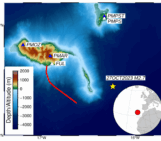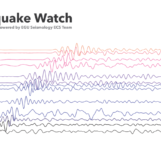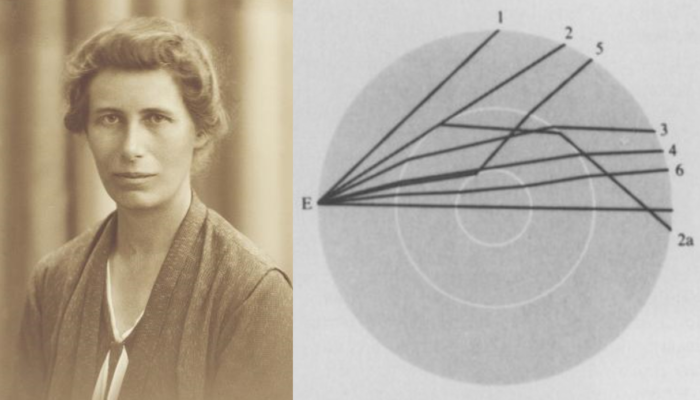
Inge Lehmann in 1932 (National Library of Denmark) and her seismological discovery of the earth's inner core, from P' (Lehmann, 1936)
It’s International Women’s Day 2023, so the EGU Seismology Division would like to celebrate the life and work of singular seismic-wave spotter – Inge Lehmann (1888-1993), a Danish seismologist who discovered that the inner core was solid!
Inge Lehmann grew up in a family of high aspirations, with several family members being politicians, scientists, and engineers. Educated in a progressive school, and taught by Hanna Adler (aunt of quantum physicist Niels Bohr), Lehmann found that she had a keen interest in science and maths, going on to study maths, with physics, chemistry and astronomy at the Universities of Copenhagen and Cambridge. Her progressive school taught women and men alike, a reality that seemed different later in life, as written by her later in 1980:
“No difference between the intellect of boys and girls was recognized, a fact that brought some disappointments later in life when I had to recognize that this was not the general attitude”.
Her university career was interrupted by health issues, and she worked for several years in an actuary office, training her in computations. Lehmann re-entered the University of Copenhagen in 1918, and in 1925 she started her journey into seismology as Assistant Professor, helping to deploy seismometers in Denmark and Greenland. She conducted several scientific visits, including a trip to Beno Gutenberg in Darmstadt, to broaden her knowledge about seismology. After graduating with an MSc in Geodesy in 1928, she went on to become chief of the seismological department of the newly founded Royal Danish Geodetic Institute, which she remained until her retirement. She was in charge of maintaining a European seismic network, improving its accuracy and co-ordination between countries. She produced the seismic bulletin, for which she interpreted and published the recorded seismograms. Although scientific work was not particularly encouraged, she started to cross-correlate the waveform arrivals by eye, with the goal of improving epicentral locations. This attention to detail and meticulous analysis led Lehmann to make a paradigm-shifting discovery…

Figure 1: A picture of Inge Lehmann from 1932 (The Royal Library, National Library of Denmark and University of Copenhagen University Library under Creative Commons License).
At this time the knowledge of Earth’s interior was restricted to the existence of a fluid core, the Mantle, and a thin crust, as was showed by Andrija Mohorovičić in 1909. Whilst analysing the seismic data from a large earthquake in New Zealand in 1929, Lehmann noticed that there were P waves appearing in unexpected locations. Specifically, they were found in assumed P-wave shadow zones: zones where, according to the liquid-core theory, P-waves should have been bent away from the solid-liquid interface and arrived elsewhere on the surface. She proposed that these P waves must have been deflected by some kind of boundary within the liquid core.
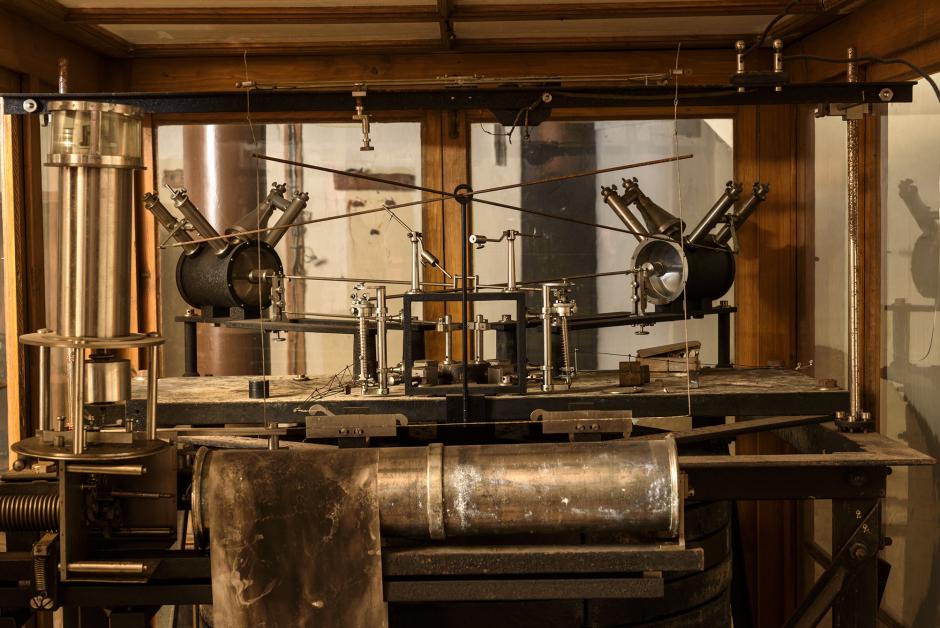
Figure 2: The seismograph in Copenhagen, of the type Wichert Horizontal Seismographs. (Photo credit: Casper Brogaard Højer)
In 1936, Lehman published her seminal paper, the pithily titled “P’” (Lehmann, 1936), suggesting that the core wasn’t all liquid, but instead had a solid inner core (which deflected the P waves) and a liquid outer core, overturning the established status-quo. The diagram in Figure 3 shows the shadow zone highlighted in blue, where ray 5 shows the ray path that was reflected by a solid inner core, thus ending up in the assumed shadow zone. After further study, she went on to discover a discontinuity in the upper mantle between 190 and 250 km (Lehmann, 1962), where seismic wave speeds increased dramatically, which was later called the Lehmann Discontinuity after her. As a result of Inge’s work, the Earth’s interior had gained a layered mantle, as well as a solid core.
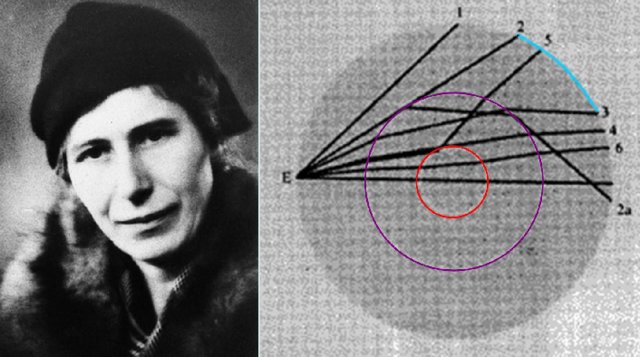
Figure 3: A picture of Inge Lehmann (left), and a scan of a diagram she drew to describe the P-wave bending around the proposed solid core. The scan is from Lehmann (1936), and this composition of the image with highlighted colors is from Herndon (2010).
Being a female scientist was pioneering in her time, meaning that Lehmann’s road to her discovery’s wasn’t smooth and contained many frustrations at the male-dominated research community. She once remarked: “you should know how many incompetent men I had to compete with in vain.” Despite these struggles, Lehmann has pushed through and made invaluable contributions to the field of seismology and Earth science in general. She was awarded two honorary doctorates and many awards for her research, sometimes being the first woman to receive these awards, and her name was immortalised as a beetle species, an asteroid, and a Google doodle! Awards are also given in her name, such as the AGU Inge Lehmann Medal, given annually to senior sceintists for outstanding contributions to the understaniding of the structure, composition, and dynamics of the Earth. Inge Lehmann lived for 104 years.
Lehmann’s career and meticulous analysis of seismic data can be an inspiration to all seismologists poring over dense forests of wiggly lines!
Further Reading:
Lehmann, I. (1936). P’. Bureau Central Seismologique International, Traveaux Scientifiques (A), 14-88.
Herndon, J. M. (2010). Inseparability of science history and discovery. History of Geo-and Space Sciences, 1(1), 25-41.
Lehmann, I. (1962). Recent studies of body waves in the mantle of the Earth. Quarterly Journal of the Royal Astronomical Society, 3, 288.
Details of life story: Rousseau, C. (2013). How Inge Lehmann discovered the inner core of the Earth. The College Mathematics Journal, 44(5), 399-408.
This piece, written by Katinka Tuinstra,
is an expanded and adapted version of a short post included within the
Seismology Division’s Advent Calendar for Christmas 2021 by Matthew Kemp.






